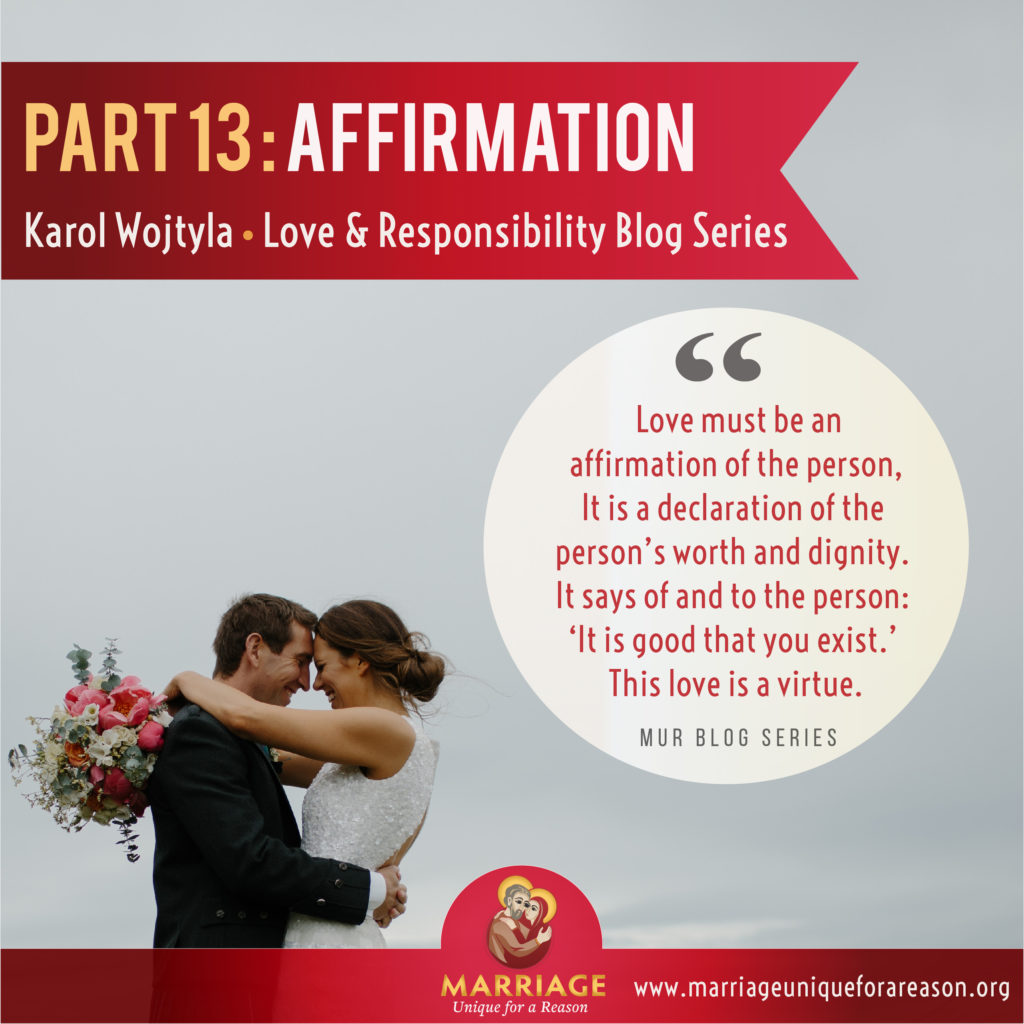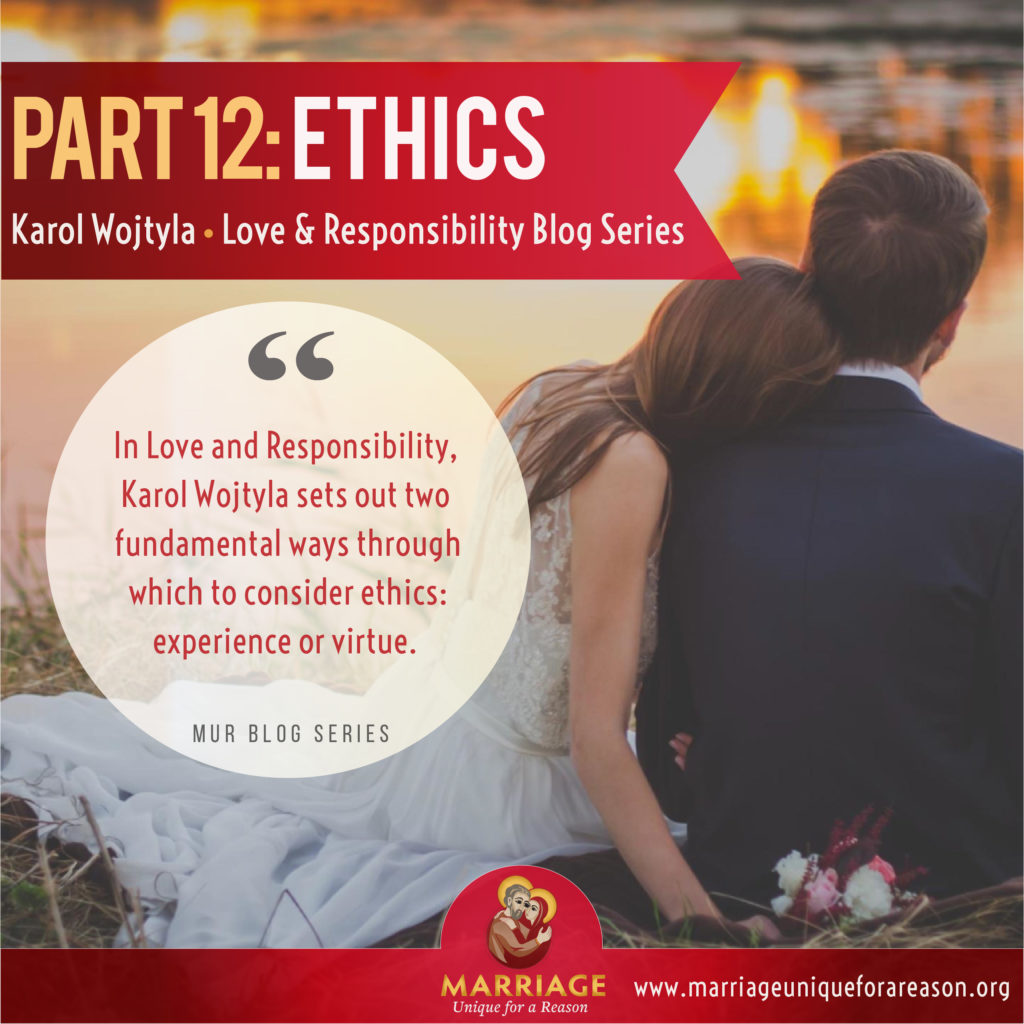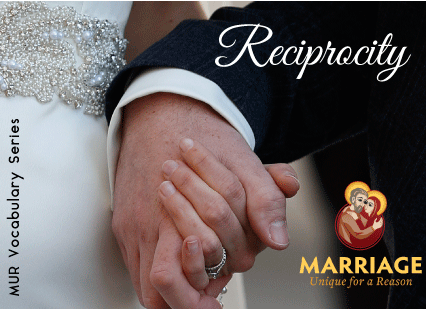Made for Love Ep 14 Fatherhood: the Masculine Genius
Fathers are a gift to their children. Fatherhood is also an immense task; a father is meant to give unconditional love and acceptance, along with protection and challenge. This episode features Bishop Sis (San Angelo), Bishop Paprocki (Springfield), Mark Hartfiel of That Man is You, Paul Jarzembowski and Andy Lichtenwalner from the USCCB, Katy Doran of CanaVox, Deborah Savage from the University of St. Thomas, and Joseph Capizzi from Catholic University.
Links to some of my guests’ organizations:
That Man Is You from Paradisus Dei
CanaVox
And as always, the episode is also on Soundcloud and iTunes (USCCB Clips)!
Archive
Made for Love Ep 10: Man and Woman: Not Two Halves, but Two Wholes
The complementarity of men and women does not mean that men and women are half-people walking around looking for their other half (sorry, Plato). This episode explores complementarity with stories from Andy Lichtenwalner, Deborah Savage, Joseph Capizzi, Pat and Elisa Fleming from Verdant View farm.
NOTE: I have just learned that the Flemings’ barn, which housed their 60 cows, burned down last week. Please pray for them.
And here are more clips from MUR videos about this theme:
Archive
Created Male and Female: An Open Letter from Religious Leaders
Today, the USCCB and a number of ecumenical and interreligious leaders released an open letter entitled, “Created Male and Female.”
Here is the text of the letter and its signers:
December 15, 2017
Dear Friends:
As leaders of various communities of faith throughout the United States, many of us came together in the past to affirm our commitment to marriage as the union of one man and one woman and as the foundation of society. We reiterate that natural marriage continues to be invaluable to American society.
We come together to join our voices on a more fundamental precept of our shared existence, namely, that human beings are male or female and that the socio-cultural reality of gender cannot be separated from one’s sex as male or female.
We acknowledge and affirm that all human beings are created by God and thereby have an inherent dignity. We also believe that God created each person male or female; therefore, sexual difference is not an accident or a flaw—it is a gift from God that helps draw us closer to each other and to God. What God has created is good. “God created mankind in his image; in the image of God he created them; male and female he created them” (Gen 1:27).
A person’s discomfort with his or her sex, or the desire to be identified as the other sex, is a complicated reality that needs to be addressed with sensitivity and truth. Each person deserves to be heard and treated with respect; it is our responsibility to respond to their concerns with compassion, mercy and honesty. As religious leaders, we express our commitment to urge the members of our communities to also respond to those wrestling with this challenge with patience and love.
Children especially are harmed when they are told that they can “change” their sex or, further, given hormones that will affect their development and possibly render them infertile as adults. Parents deserve better guidance on these important decisions, and we urge our medical institutions to honor the basic medical principle of “first, do no harm.” Gender ideology harms individuals and societies by sowing confusion and self-doubt. The state itself has a compelling interest, therefore, in maintaining policies that uphold the scientific fact of human biology and supporting the social institutions and norms that surround it.
The movement today to enforce the false idea—that a man can be or become a woman or vice versa—is deeply troubling. It compels people to either go against reason—that is, to agree with something that is not true—or face ridicule, marginalization, and other forms of retaliation.
We desire the health and happiness of all men, women, and children. Therefore, we call for policies that uphold the truth of a person’s sexual identity as male or female, and the privacy and safety of all. We hope for renewed appreciation of the beauty of sexual difference in our culture and for authentic support of those who experience conflict with their God-given sexual identity.
Sincerely Yours:
Most Rev. Joseph C. Bambera
Bishop of Scranton
Chairman, USCCB Committee on Ecumenical and Interreligious Affairs
The Most Rev. Dr. Foley Beach
Archbishop and Primate
Anglican Church in North America
The Rev. John F. Bradosky
Bishop
North American Lutheran Church
Most Rev. Charles J. Chaput, O.F.M. Cap.
Archbishop of Philadelphia
Chairman, USCCB Committee on Laity, Marriage, Family Life and Youth
Most Rev. James D. Conley
Bishop of Lincoln
Chairman, USCCB Subcommittee for the Promotion and Defense of Marriage
The Rt. Rev. John A. M. Guernsey
Bishop, Diocese of the Mid-Atlantic
Anglican Church in North America
Rev. Dr. Matthew Harrison
President
Lutheran Church–Missouri Synod
Imam Faizal Khan
Founder and Leader
Islamic Society of the Washington Area
Most Rev. Joseph E. Kurtz
Archbishop of Louisville
Chairman, USCCB Committee for Religious Liberty
Melchisedek
Archbishop of Pittsburgh
Orthodox Church in America
The Rt. Rev. Eric V. Menees
Bishop of San Joaquin
Anglican Church in North America
Rev. Eugene F. Rivers, III
Founder and Director
Seymour Institute for Black Church and Policy Studies
Church of God in Christ
Rev. Dr. Gregory P. Seltz, PhD
Executive Director
The Lutheran Center for Religious Liberty
The Rev. Paull Spring
Bishop Emeritus
The North American Lutheran Church
Rev. Tony Suarez
Executive Vice President
National Hispanic Christian Leadership Conference
Very Rev. Nathanael Symeonides
Ecumenical Officer
Greek Orthodox Archdiocese of America
The Rev. Dr. L. Roy Taylor
Stated Clerk of the General Assembly
Presbyterian Church in America
Andrew Walker
Director of Policy Studies
Southern Baptist Ethics & Religious Liberty Commission
The Rev. Dr. David Wendel
Assistant to the Bishop for Ministry and Ecumenism
The North American Lutheran Church
Paul Winter Elder
Bruderhof
Archive
Affirmation: Love and Responsibility Series (Post #13)
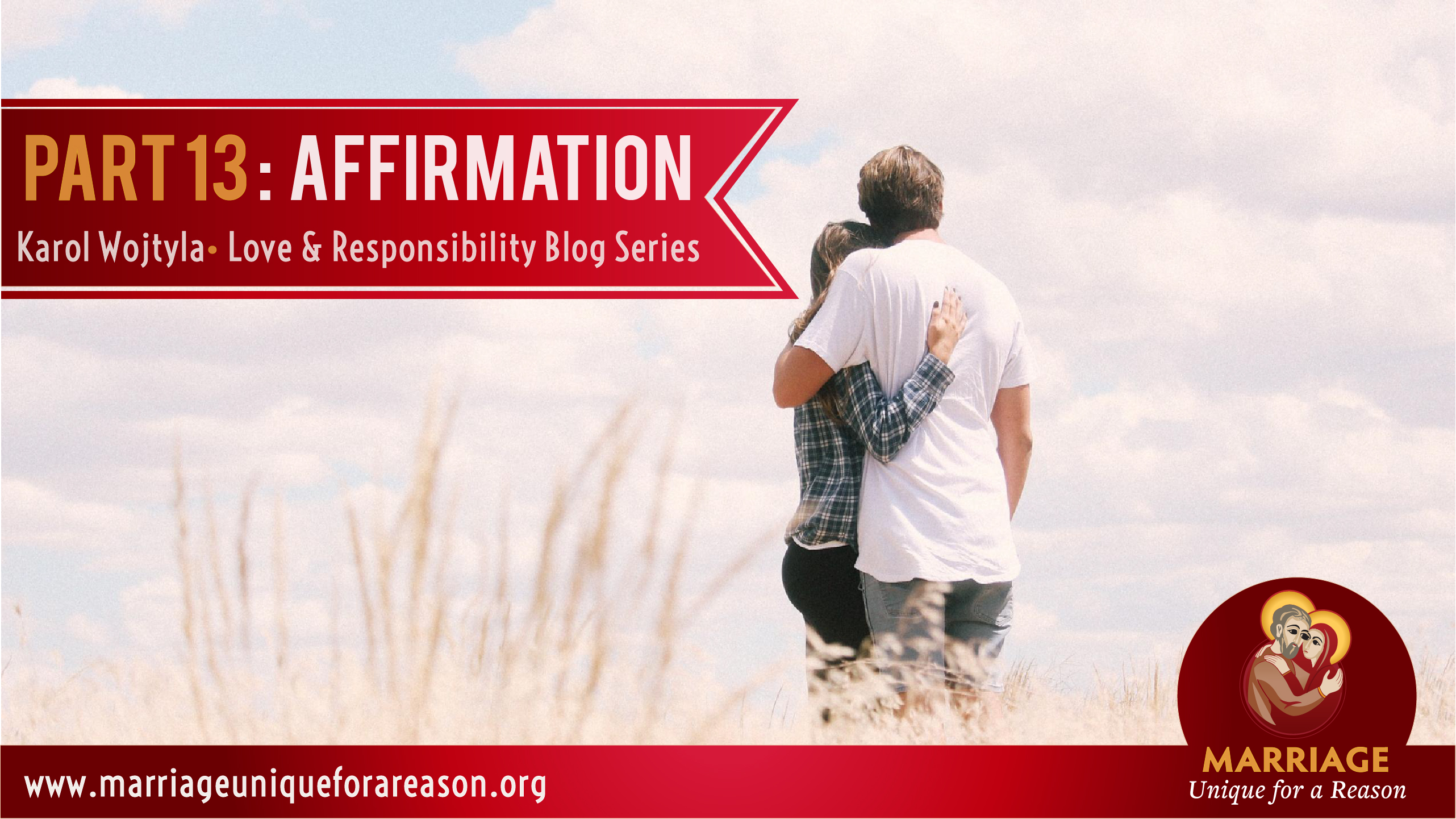
The Inherent Value of the Human Person
Karol Wojtyla reminds us in this section of Love and Responsibility that a person has worth beyond any other created thing or object in the world. A person has an inner life (spirit) and is capable of spiritual perfection (in heaven). The inherent value of every human person goes far beyond any quality that they may possess (such as beauty, brains, or brawn). [This is one reason that racism is clearly an evil, since it reduces the value of the person due to an accidental[i] quality.] The human person has unique dignity because he or she is made in God’s image and called to communion with him. 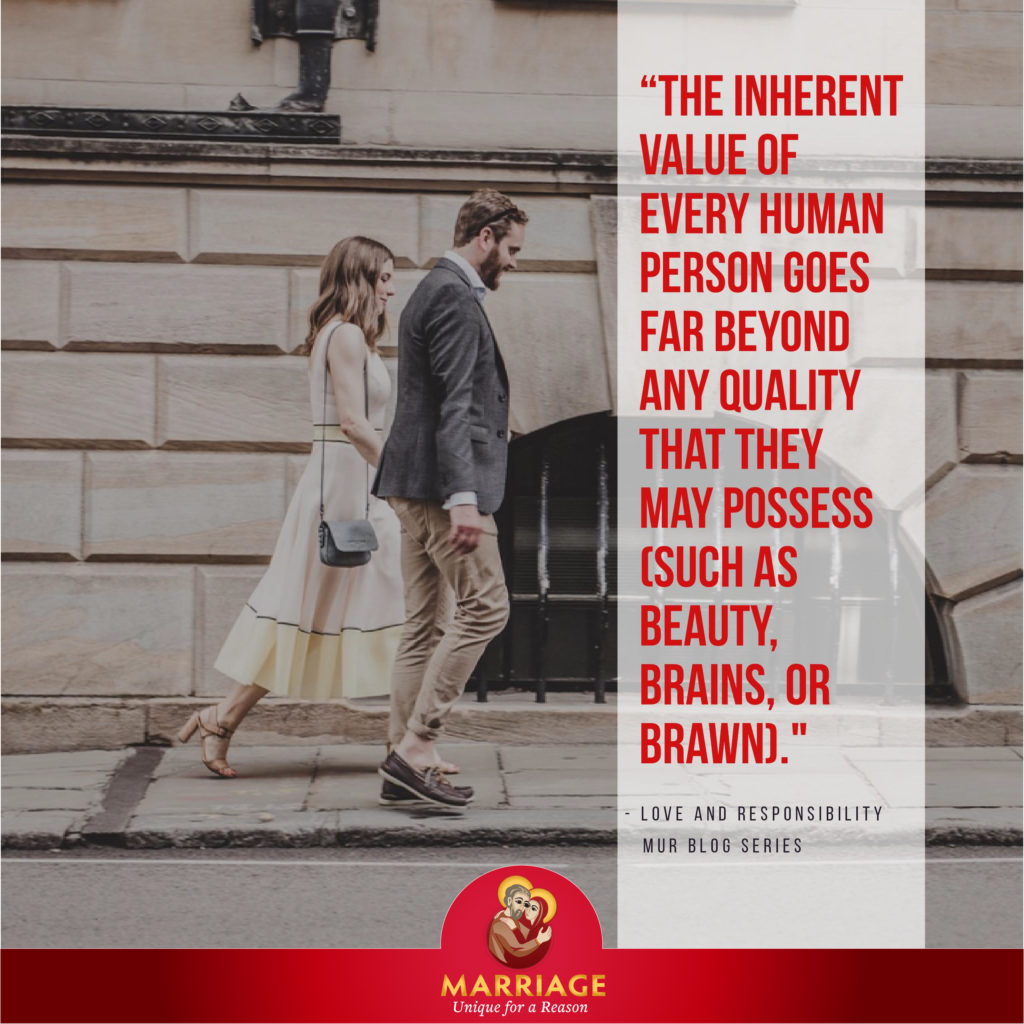
“That being so,” Wojtyla writes, “every person of the opposite sex possesses value in the first place as a person, and only secondarily possesses a sexual value.”[ii] Everyone is a person first, man or woman second. Experientially, when a man meets a woman, he typically sees her as a woman (and vice versa, when a woman meets a man, he registers as “male”) but the fact that the other is a person, “demands that the sensual and emotional reaction to a ‘human being of the other sex’ be somehow adjusted to the knowledge that the human being concerned is a person.”[iii] Harry isn’t just some kind of incarnation of maleness, and Sally isn’t just some beautiful piece of art to gaze at; they are persons whom God loves.
The Affirmation of the Person
Love must be an affirmation of the person, per Wojtyla; It is a declaration of the person’s worth and dignity. It says of and to the person: “It is good that you exist.” This love is a virtue, an “authentic commitment of the free will of one person… resulting from the truth about another person.”[iv] Affirmation of the person is connected with the other aspects of love (sensuality, emotion) but not reducible to them. The full truth of the person—with his or her faults and weaknesses as well as virtues and gifts—must be seen and accepted by the one who truly loves. 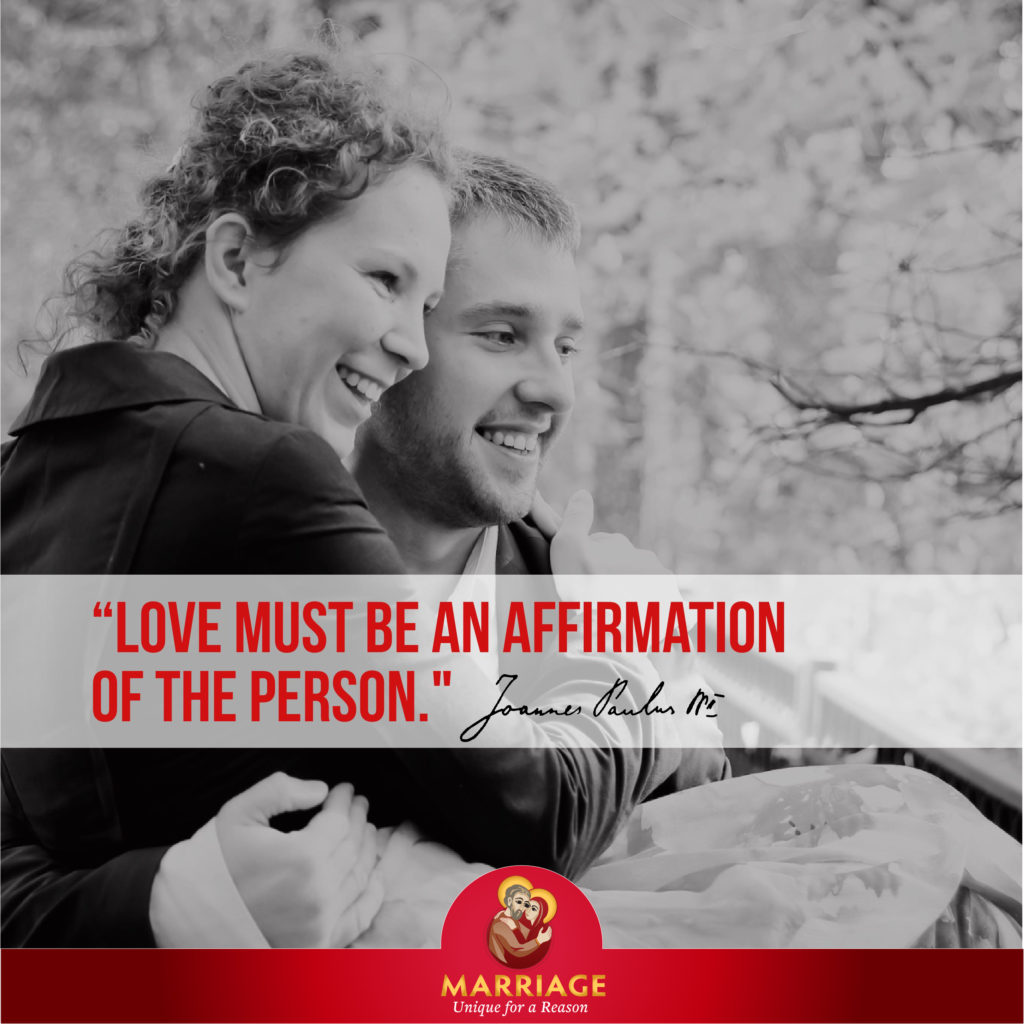
Learning this virtue of charity/love by focusing on affirming the person leads to two other developments in a person’s life. One is growth in the virtue of chastity, exhibiting self-control over one’s sensual and emotional reactions. Second is the discernment of one’s vocation or state in life (marriage or celibacy for the Kingdom). Both states in life are based on the call to love—to affirm every person—in a particular way.
In the next section, Wojtyla continues contemplating the necessity of marital love to be both subjective and objective, repeating much of what has been said before. He talks of what it takes for two people to belong to one another in love. A point he reiterates from earlier is the necessity of each person to know their own worth and dignity as a person before entering a relationship. “A woman is capable of truly making a gift of herself only if she fully believes in the value of her person and in the value as a person of the man to whom she gives herself.”[v] This can be assumed to be reciprocal. One of the challenges of love between a man and a woman is each internalizing that he or she is worthy of it.
[i] Please note the use of the term “accidental” in its philosophical meaning as un-essential, or not determinative of the thing’s nature. For example, for a cat, having long fur is an “accident” while being a creature with four paws and a superiority complex is essential.
[ii] Wojtyla, Karol. Love and Responsibility (San Francisco: Ignatius Press, 1993), p. 122.
[iii] Ibid, p. 123, emphasis original.
[iv] Ibid, p. 123.
[v] Ibid, p. 129.
Archive
Ethics: Love and Responsibility (Post #12)
 To begin his formal ethical analysis of love in Love and Responsibility, Karol Wojtyla sets out two fundamental ways through which to consider ethics: experience or virtue.
To begin his formal ethical analysis of love in Love and Responsibility, Karol Wojtyla sets out two fundamental ways through which to consider ethics: experience or virtue.
Ethics of Experience:
Wojtyla starts with the use of experience as a guideline for ethics. Situationalism (or relativism) sees every situation as unique in such a way that there can be no objective rules about behavior. What is right or wrong in a given situation just 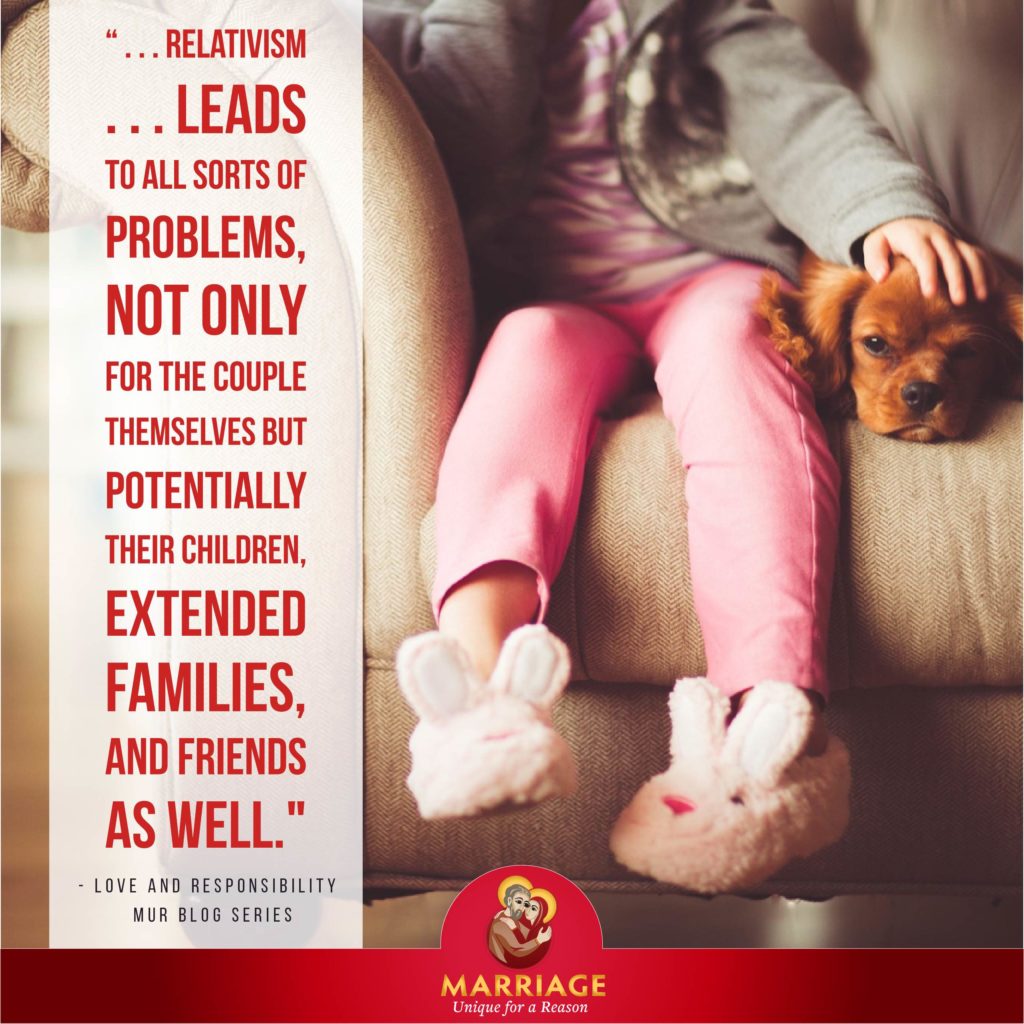 depends on the situation and the people in it. The people themselves are the only ones who can know (or say) what is good for them. So when it comes to the relationship between a man and a woman, anything goes as long as it “works” for the couple. Hopefully, it is obvious that this kind of ethical system leads to all sorts of problems, not only for the couple themselves but potentially their children, extended families, and friends as well.
depends on the situation and the people in it. The people themselves are the only ones who can know (or say) what is good for them. So when it comes to the relationship between a man and a woman, anything goes as long as it “works” for the couple. Hopefully, it is obvious that this kind of ethical system leads to all sorts of problems, not only for the couple themselves but potentially their children, extended families, and friends as well.
Ethics of Virtue:
In contrast, according to the ethics of virtue, it is a person’s duty to choose what is good. What is good is not decided by the person himself but rather determined by some objective rule or norm. “For the freedom of the human will is most fully displayed in morality through duty,”[1] Wojtyla writes. A duty is discovered, not created, through applying a norm. For Wojtyla, the personalistic norm (i.e. the command to love) furnishes the “should’s” and “should not’s” of the relationship between man and woman. Whatever is done should be done out of love, not lust or emotional manipulation. 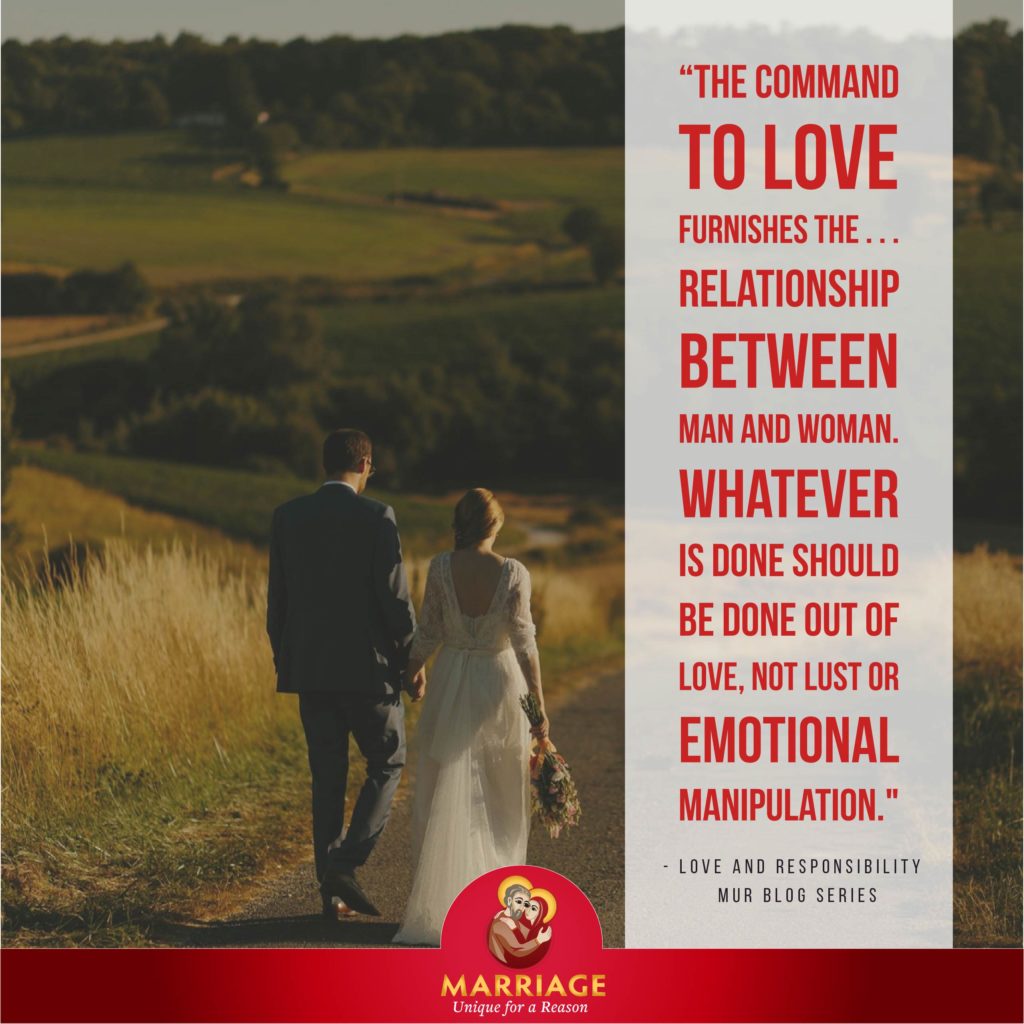 Wojtyla argues that without ethical completeness (respect, love for the other over oneself, etc.), there is no psychological completeness to love either. In other words, if love as a virtue is not present in the relationship between a man and a woman, it will not even be psychologically satisfying in the end because it is not authentic love.
Wojtyla argues that without ethical completeness (respect, love for the other over oneself, etc.), there is no psychological completeness to love either. In other words, if love as a virtue is not present in the relationship between a man and a woman, it will not even be psychologically satisfying in the end because it is not authentic love.
Consider these two approaches to ethics as if they were applied to eating. Situationalism would say that whatever you eat is fine, if you think it is. Doughnuts every day? Go for it! Only you can know if that is a good breakfast for you. Virtue, on the other hand, requires you to consider the objective nutritional value of the food and act accordingly. That doesn’t mean that you always make the right decision, but that you know there is a right to strive for.
So how do a man and woman grow in the Christian virtue of love/charity? Stay tuned!
Click the link below to read ALL of MUR’s Love and Responsibility blog series: https://goo.gl/6itvJH
[1] Wojtyla, Karol. Love and Responsibility (San Francisco: Ignatius Press, 1993), p. 120.
Archive
Two Minds: Sexual Difference in the Brain
Scientific evidence continues to demonstrate that men and women are different in thousands of ways. Biological differences, which are never only biological, since we are composite beings of body and soul, affect men and women in myriad ways. A recent article out of Stanford Medical School enumerates a few of the neurological differences between male and female brains and the corresponding behavioral differences and susceptibilities to various disorders.
We are called to value our differences, not ignore or negate them. As Pope Francis said, “For example, I ask myself, if the so-called gender theory is not, at the same time, an expression of frustration and resignation, which seeks to cancel out sexual difference because it no longer knows how to confront it. Yes, we risk taking a step backwards. The removal of difference in fact creates a problem, not a solution” (General Audience on Man and Woman, April 15, 2015).
Archive
Sexual Difference Matters: Made for Life Series
We finish this series on Made for Life with a clip of Katie and Pete talking about the way that marriage provides the “perfect” setting to raise a child. It takes a man and a woman to bring a new human being into the world. Two men or two women simply cannot do this. So if sexual difference is the basic necessity for conceiving a child, then it makes sense that sexual difference would also be important for raising that child. A mother and a father bring balance and ensure that children always have one person similar to and one persondifferent from them to look up to.
A child’s “first right” is to “be born in a real family,” that is, to be born to his or her own father and mother, bonded in marriage.[i] Protecting this right is a matter of social justice. As the bishops have taught, “To promote and protect marriage as the union of one man and one woman is itself a matter of justice. In fact, it would be a grave injustice if the state ignored the unique and proper place of husbands and wives, the place of mothers and fathers, and especially the rights of children, who deserve from society clear guidance as they grow to sexual maturity.”[ii]
It is sometimes claimed that what really matters for a child is the presence of any two loving, committed adults, regardless of their sex/gender. But there are major problems with this assertion. First, two men or two women are physically incapable of having a child together. Nothing they do can change this fact. Instead, two people of the same sex must either attempt to adopt a child or contract with a “third party” egg or sperm donor who contributes one-half of the child’s genetic material. This means that placing a child in the care of two men or two women deliberately separates that child from his or her father or mother in every single case. Then, those children are further denied the benefit of witnessing a healthy relationship between a father and mother and the experience of the parental love of either a man or a woman. Children deserve better.
Discussion Questions
- Why do you think the Church teaches that a child has a right to be born into a family?
- How does having a mother and father give the child the balance he or she needs?
- What other topics would you like to explore with Marriage Unique for a Reason? Leave a comment and let us know!
[i] Compendium of the Social Doctrine of the Church, no. 244.
[ii] Marriage: Love and Life in the Divine Plan, 22. The needs and rights of the child should be of fundamental concern for every society and community, as is acknowledged in “the principle, recognized also in the United Nations Convention on the Rights of the Child, that the best interests of the child, as the weaker and more vulnerable party, are to be the paramount consideration in every case.” CDF, Considerations Regarding Proposals to Give Legal Recognition to Unions Between Homosexual Persons (2003), no. 7, www.vatican.va/roman_curia/ congregations/cfaith/documents/rc_con_cfaith_doc_20030731_homosexual-unions_en.html.
Archive
Mothers and Fathers are Different: Made for Life Series
This week’s clip begins with Katie and Pete talking about how they play differently with their kids, and moves to Pete talking about society’s obligation to support that which is best for children.
That mothers and fathers are different is a common sense and intuitive statement. It does not mean that “All moms do X” or “All dads do Y” but rather that mothers and fathers, even when they do the exact same thing, do not do it the same way. Men and women just do things differently.
Why is this important and beneficial for children? Sociologically, we don’t know, we only know that it appears to be the case. Philosophically, we can understand it because we know ourselves to be one sex or the other, and therefore seeing both ways of being human every day informs our self-understanding as well as an understanding that there is always another way of being. And theologically, we can see that if sexually-differentiated humanity is really “the image of God,” then our image of God, our idea of who God is and how God loves us, will be incomplete without seeing the love of a man and a woman lived out before us.
And if we know that it’s important for kids to have a mother and a father, and that even if we don’t know why, children consistently do better in that environment, shouldn’t we promote and defend it?
Discussion Questions
- What are practical ways that you can promote and defend marriage today?
- What are examples from your own family of how masculinity and femininity is displayed and honored in a day-to-day way?
Archive
Children Deserve Both a Mother and a Father: Made for Life Series
As discussed last week, single parents can still honor the importance of sexual difference by acknowledging the unique difficulties their families face, but two persons of the same sex who raise a child are unable to do so.
Two men or two women who claim to replace a mother and a father reject the vital role that parental sexual difference plays in the development of a child, especially the child’s sexual identity. Children look to their parents to figure out what it means to be a boy or a girl and how to relate to the opposite sex. When there is not a model in the home of one sex or the other, one of these developmental tasks the child faces necessarily and by definition is made incredibly difficult. How can John understand what it means to be a man when he primarily only sees two women interacting? How can Anna understand her worth as a woman if her two caregivers are both men? As adults, it can be hard to remember what it is to be a child, completely dependent on our parents and constantly absorbing things (largely unconsciously) that shape our understanding of the world. These things aren’t quantifiable or really even “proveable”. We know by faith, in a way, that based on the Catholic understanding of who the human being is, being raised by two men or two women wounds a child. Of course, these wounds are not incurable; the Divine Physician is always ready to heal and transfom the hurts that we sustain as children. But that does not mean that we do not do all that we can as a Church and society to prevent predictable suffering.
Too much of the discussion around marriage redefinition revolved around the supposed “rights” of adults to sexual and social “fulfillment” in a recognized legal partnership rather than the rights of children to know and be raised by their parents. (Or, ironically, one of the Justices argued that “children of same-sex couples” had the right for their “parents” to be recognized by the State, ignoring the fact that, by nature and rights, there are no “children of same-sex couples” except those procured by an unjust system.)
One of the reasons that it is hard to explain and defend the Church’s position on marriage is that, as a society, we have conceptually separated two things that should be together: marriage and having children. We must help our contemporaries to see that these two things belong together, so that we can minimize the damage that will be done to young lives by the choices of adults.
Discussion Questions
- What does it mean that single parents can still “honor” the importance of sexual difference in the lives of their children?
- Consider your experience as a child. What do you think you learned by watching your mother and father interact?
- Given that a child being raised in a same-sex household suffers a wound, how can the Church better support those children?
Archive
What Is Marriage All About?
The final section we are going to discuss from Made for Each Other has to do with what is traditionally called the two “ends” (or purposes, reasons for existing) of marriage. The Church teaches that because marriage is the total gift of one spouse’s life to the other, it entails both the gift of love and the gift of children. Marriage is the gift for life and the gift of life. It’s unique and irreplaceable—the fundamental institution for life.
The Church affirms that the love of husband and wife is a great good in and of itself, even if they do not receive the gift of a child. Human marriage is a foreshadowing of the marriage between Christ and his Church and sacramental marriage participates in and shows forth this love (see Eph 5:28-33).
Marriage lived in truth is an indispensable model of communion for the world and an affirmation that life is good. The love of husband and wife reminds us all that no one is an isolated individual, that we need one another at the most fundamental level. This love is meant to be the context for welcoming, forming, and educating new life. This is why marriage, as a personal relationship, has always been recognized to have great, public significance. The love of spouses, the responsibilities of mothers and fathers, and the rights of children—all are tied to the unique truth of marriage and its protection and promotion.
The Church will never waver in her teaching that marriage is the lifelong union of a woman and a man, open to life. From the beginning, man and woman are made for each other. There is nothing else like it.
Discussion questions:
- How is marriage the “gift for life” and the “gift of life”?
- The public proposal to “redefine” marriage to include persons of the same sex is fairly recent. How is it connected to a larger confusion around the meaning of the person and sex?
- How is this meaning inseparable from the truth of marriage as the union of one man and one woman?
***
For this reason a man shall leave his father and mother and be joined to his wife, and the two shall become one flesh. (Mt 19:5)
Archive
What Are These Differences?
In this section of Made for Each Other, Josh and Carrie explore what sexual difference may look like in a given couple. Men and women are, as Carrie puts it, “different in ways that will always matter.” Biology is important, but the body and the person are not reducible to biology. Sexual difference involves the whole person, body and soul.
The body reveals the person. We’re not souls trapped in bodies. We’re “body-persons.” We don’t just have a body. We are our bodies. (We even have words for people who are without one or the other—a corpse is a body that is missing a soul; a ghost is (perhaps) a soul missing a body.) The body of a man and the body of a woman are distinct, personal realities. In addition, as Pope St. John Paul II taught, these bodies have a “spousal meaning.”[i] The body, in its masculinity or femininity, reveals that we are persons who are made to be a gift to others and to be received as a gift by others.
Every human person shares the same nature (human) and the same dignity, made in the image of God. Our sexual identity as a man or a woman is the way in which that humanity is manifested. This identity is meant to be acknowledged and accepted as a gift from God.[ii] It has significance for all the various ways we relate to others: we are a daughter or a son, a sister or a brother, a mother or a father.
While some play down the reality of sexual difference or limit it to the differences between female and male anatomy, sciences such as neurobiology, evolutionary psychology, endocrinology, histology, and reproductive physiology—to name a few—point to the intricate, unique, and complementary physiologies of women and men. We may have conversations differently; take risks differently; form and process relationships differently; respond to threats differently. These differences do not imply that one sex is superior to the other. Men and women are just different. Admitting this does not diminish either sex but serves to enhance the possibility of their unity in love.
Of course, men and women differ among themselves, as well as differing from each other. Sex differences in each and every trait need not be present in each and every individual woman or man. But the way a trait is lived out will always be distinct, whichever person, man or woman, is exhibiting it. For example, the way that St. Joan of Arc was a soldier was not the same as a man’s way.
Our gender, which can be distinguished but not separated from our sex,[1] is a fundamental “given” in our lives. Male and female are two different ways of being human, body and soul.
Discussion questions:
- What does it mean to say that “the body reveals the person”?
- How do equality and difference go together when speaking of man and woman? How does complementarity depend upon difference?
[1] See Amoris Laetitia, no. 56.
[i] See TOB, 13:1–16:2. See also Pope John Paul II’s Familiaris Consortio, no. 37, and Veritatis Splendor, no. 15.
[ii] See CCC, nos. 2332-2333.
Archive
Sexual Difference Does Not Compete, It Complements
In our second clip from Made for Each Other, Carrie ends with the comment, “Our sexual difference doesn’t compete; it complements.” Sexual unity and the coming-to-be of babies depend on the difference between man and woman. The husband gives his whole self (body, mind, heart, soul) to his wife; the wife gives her whole self to her husband. This happens in a particularly clear and dramatic way when the gift of the body is offered in marital intercourse. The spouses give themselves and receive each other in and through their difference. As Josh says, “every natural process of the body” can be done by oneself—“everything but making love and having children,” which depends upon the other person being different. Sexual difference is the avenue towards real union, a union that is also open to life.
Sexual difference concerns the whole person, as Carrie points out. Only through this difference can a man and a woman give themselves fully and love each other as spouses. This isn’t unjust discrimination; it’s an actual distinction, a matter of reality. Sexual intercourse in marriage is a way of communicating, it is a language spoken face-to-face. Part of the essential grammar of this language is sexual difference. Without it, marriage can’t be spoken of.[i]
Men and women are equal and different. Difference is a great and necessary good. “It’s constructive,” as Josh says. Sexual difference is what enables a man and a woman to form a unique bond for life, a union that is deeper than friendship and lasts until death. A husband gives to his wife what only a husband can give. Likewise, a wife gives to her husband what only a wife can give. And together, they give the world new life!
Discussion questions:
- Do you think sexual difference is understood and appreciated today? Why or why not?
- How can we help others reflect on the importance of sexual difference and complementarity?
[i] This is also why sex outside of marriage doesn’t make any sense. Sex itself speaks a language of total commitment and gift—faithful and indissoluble love. That’s the language of marriage. Sex outside of marriage always says something that is untrue. It’s pretending. Real love depends on truth, and truth depends on love (see Pope Benedict XVI, Encyclical Caritas in Veritate [Washington, DC: USCCB, 2009], nos. 1-9).
Archive
Made “For Each Other”
In this segment of the video, Josh and Carrie discuss the way that marriage is not like being roommates who live together, but separately. Man and woman are made for each other in a way that is absolutely unique. We see this through their sexual difference, even if we just look to the human body as male or female. A man’s body does not make sense by itself, nor does a woman’s; only together is it possible to get the whole picture of humanity. At a deeper level, as Josh says in the video, there is also a longing of the one for the other. There are always and only two ways of being human[1]: we cannot be the other, so we want to be with the other.
We are made for union and communion, to be in relation with others.[i] In Genesis, God says, “It is not good for the man to be alone” (Gn 2:18). God’s solution to man’s isolation is not to create another identical man. Rather, He creates a woman from the man’s side and gives the two to each other in the first marriage. “For this reason, a man shall leave his father and mother and be joined to his wife, and the two shall become one flesh” (Mt 19:5; cf. Gn 2:24).
The two become one flesh in the physical act of sexual intercourse, in which the bodies of the man and woman cooperate in an act which may bring about the procreation of another human being. As Eve says, “I have produced a male child with the help of the LORD”(Gn 4:1). There is only one “combination” of human bodies that can produce new life: a man and a woman. If you accept the idea that human life has special value, then you should also accept that the (one and only) natural action that can bring this life into existence is, by that fact, unique in its power and importance to the world.
The truth of the human person, created male and female, and the truth of what marriage is, are not only concerns of religion or religious people—they are truths that affect everyone.
Discussion question:
- Why is it important to society that marriage be based on sexual difference?
- Why is the fact of our being created male and female not simply a tool for the survival of the species?
[1] Even in those rare cases of atypical genetic or physical development, the fundamental question is whether the person is male or female. There are only “X” and “Y” chromosomes, there is no “other” sex. In such cases, we rely on natural science that can help determine biological sex. This knowledge will help the person to understand his or her sexual identity.
[i] See CCC, nos. 45, 371-372, 1603-1604, and 1877-1879.
Archive
Made for Each Other: Short Segments for Study
Introduction
But God did not create man a solitary being. From the beginning “male and female he created them” (Gn 1:27). This partnership of man and woman constitutes the first form of communion between persons.
–Second Vatican Council, Pastoral Constitution Gaudium et Spes (1965), no. 12[i]
What is marriage?
The question of what marriage is has been largely ignored in debates about who can get married. Before asking who can get married, one should ask what “marriage” is. What is this relationship that two (or more) people want the state to recognize, and why should society care about it?
Let’s see what definitions are out there and how they measure up to what we all kinda-sorta-in-our-bones know about what marriage is.
Google: the legally or formally recognized union of a man and a woman (or, in some jurisdictions, two people of the same sex) as partners in a relationship.
“Union… as partners in a relationship.” Well, what kind of relationship? What about business partnerships or siblings? What kind of union?
Merriam-Webster: a (1): the state of being united to a person of the opposite sex as husband or wife in a consensual and contractual relationship recognized by law (2): the state of being united to a person of the same sex in a relationship like that of a traditional marriage <same-sex marriage>
This one is interesting because, as you see, the authors have to resort to comparing “the state of being united to a person of the same sex” as being like “traditional marriage” in order to explain it. It’s definitely better than Google’s definition, since it gets to the parties “being united… in a consensual and contractual relationship” but once again, we could say that the same would apply to different kinds of “consensual and contractual relatinoships”.
Oxford Dictionary: The legally or formally recognized union of two people as partners in a personal relationship (historically and in some jurisdictions specifically a union between a man and a woman).
This is probably the most accurate definition of the way the majority of people understand marriage today: “union of two people as partners in a personal relationship.” It is worth asking, then, why the government has any interest in personal relationships.
It seems like all these definitions lack something.
If you really take the time to think about the definition of marriage, you will discover that there is only one definition of marriage that truly fits with who we are as human beings (body and soul, male and female) and seems to get at what is fundamental: marriage is the lifelong, exclusive union of one man and one woman, open to life.[ii]
This definition expresses what marriage is when it is lived truly, and this is a grace available to every married couple. But in this world of brokenness, we have all witnessed a general weakening of people’s understanding and living out this truth. The cultural and legal connections among marriage, sexual intercourse, childbearing, and childrearing have been slowly chipped away at, whether through acceptance of extra-marital sex and cohabitation on the one hand, or third-party reproduction on the other. One can easily see that our society as a whole has lost a consciousness of what men and women are called to be for one another.
God’s vision and plan for marriage is an ideal but it is not idealistic. As Pope Francis taught in Amoris Laetitia, “in no way must the Church desist from proposing the full ideal of marriage, God’s plan in all its grandeur.”[iii] And again, he writes, “Married couples are grateful that their pastors uphold the high ideal of a love that is strong, solid, enduring and capable of sustaining them through whatever trials they may have to face.”[iv] Marriage is a communion of persons, a communion of love between husband and wife, meant to be the source of the family and society. That’s why, when the Pharisees questioned Jesus about divorce, He refered back to creation, when Adam and Eve were given in relationship to one another for life (see Mt 19:4-6; Mk 10:6-8).[v]
The series we are beginning on the MUR blog next week accompanies short segments of the video Made for Each Other. In this video, actors playing Josh and Carrie discuss the importance of sexual difference to marriage and the complementarity between man and woman. During these four weeks, we will explore these themes a bit more. Much of the posts will contain text found in the Viewer’s Guide of Made for Each Other. The questions provided can be used for personal reflection or for group discussion.
[i] See Austin Flannery, ed., Vatican Council II: Volume 1: The Conciliar and Post Conciliar Documents, new rev. ed. (Northport, NY: Costello Publishing, 1996).
[ii] See CCC, nos. 1601-1605.
[iii] Amoris Laetitia, no. 307.
[iv] Amoris Laetitia, no. 200.
[v] See Pope John Paul II, Man and Woman He Created Them: A Theology of the Body (TOB), trans. Michael Waldstein (Boston: Pauline Books & Media, 2006), 1–4 (audience numbers); Pope John Paul II, Encyclical Veritatis Splendor (Washington, DC: USCCB, 1993), nos. 22 and 53.
Archive
Archbishop Chaput 2016 Tocqueville Lecture
Archbishop Chaput, Chairman-Elect for the Committee on Laity, Marriage, Family Life and Youth at the USCCB, gave the Tocqueville Lecture at the University of Notre Dame on September 15th, 2016. The full text is available here. The middle section, reprinted here, examines the importance of a true understanding of human sexuality:
So, what does any of this have to do with sex, family and the liberty of the Church? I’ll answer the question this way.
I’ve been a priest for 46 years. During that time I’ve heard something more than 12,000 personal confessions and done hundreds of spiritual direction sessions. That’s a lot of listening. When you spend several thousand hours of your life, as most priests do, hearing the failures and hurts in people’s lives – men who beat their wives; women who cheat on their husbands; the addicts to porn or alcohol or drugs; the thieves, the hopeless, the self-satisfied and the self-hating – you get a pretty good picture of the world as it really is, and its effect on the human soul. The confessional is more real than any reality show because nobody’s watching. It’s just you, God and the penitents, and the suffering they bring with them.
As a priest, what’s most striking to me about the last five decades is the huge spike in people – both men and women — confessing promiscuity, infidelity, sexual violence and sexual confusion as an ordinary part of life, and the massive role of pornography in wrecking marriages, families and even the vocations of clergy and religious.
In a sense, this shouldn’t surprise. Sex is powerful. Sex is attractive. Sex is a basic appetite and instinct. Our sexuality is tied intimately to who we are; how we search for love and happiness; how we defeat the pervasive loneliness in life; and, for most people, how we claim some little bit of permanence in the world and its story by having children. The reason Pope Francis so forcefully rejects “gender theory” is not just because it lacks scientific support — though it certainly has that problem. Gender theory is a kind of metaphysics that subverts the very nature of sexuality by denying the male-female complementarity encoded into our bodies. In doing that, it attacks a basic building block of human identity and meaning — and by extension, the foundation of human social organization.
But let’s get back to the confessional. Listening to people’s sexual sins in the Sacrament of Penance is hardly new news. But the scope, the novelty, the violence and the compulsiveness of the sins are. And remember that people only come to Confession when they already have some sense of right and wrong; when they already understand, at least dimly, that they need to change their lives and seek God’s mercy.
That word “mercy” is worth examining. Mercy is one of the defining and most beautiful qualities of God. Pope Francis rightly calls us to incarnate it in our own lives this year. Unfortunately, it’s also a word we can easily misuse to avoid the hard work of moral reasoning and judgment. Mercy means nothing – it’s just an exercise in sentimentality – without clarity about moral truth.
We can’t show mercy to someone who owes us nothing; someone who’s done nothing wrong. Mercy implies a pre-existing act of injustice that must be corrected. And satisfying justice requires a framework of higher truth about human meaning and behavior. It requires an understanding of truth that establishes some things as good and others as evil; some things as life-giving and others that are destructive.
Here’s why that’s important. The truth about our sexuality is that infidelity, promiscuity, sexual confusion and mass pornography create human wreckage. Multiply that wreckage by tens of millions of persons over five decades. Then compound it with media nonsense about the innocence of casual sex and the “happy” children of friendly divorces. What you get is what we have now: a dysfunctional culture of frustrated and wounded people increasingly incapable of permanent commitments, self-sacrifice and sustained intimacy, and unwilling to face the reality of their own problems.
This has political consequences. People unwilling to rule their appetites will inevitably be ruled by them — and eventually, they’ll be ruled by someone else. People too weak to sustain faithful relationships are also too weak to be free. Sooner or later they surrender themselves to a state that compensates for their narcissism and immaturity with its own forms of social control.
People too worried or self-focused to welcome new life, to bear and raise children in a loving family, and to form them in virtue and moral character, are writing themselves out of the human story. They’re extinguishing their own future. This is what makes the resistance of so many millennials to having children so troubling.[1]
The future belongs to people who believe in something beyond themselves, and who live and sacrifice accordingly. It belongs to people who think and hope inter-generationally. If you want a portrait of what I mean, consider this: The most common name given to newborn male babies in London for the past four years in a row is Muhammad. This, in the city of Thomas More.
Weak and selfish individuals make weak and selfish marriages. Weak and selfish marriages make broken families. And broken families continue and spread the cycle of dysfunction. They do it by creating more and more wounded individuals. A vast amount of social data shows that children from broken families are much more likely to live in poverty, to be poorly educated, and to have more emotional and physical health issues than children from intact families. In other words, when healthy marriages and families decline, the social costs rise.
The family is where children discover how to be human. It’s where they learn how to respect and love other people; where they see their parents sacrificing for the common good of the household; and where they discover their place in a family story larger than themselves. Raising children is beautiful but also hard work. It’s a task for unselfish, devoted parents. And parents need the friendship and support of other likeminded parents. It takes parents to raise a child, not a legion of professional experts, as helpful as they can sometimes be.
Only a mother and father can provide the intimacy of maternal and paternal love. Many single parents do a heroic job of raising good children, and they deserve our admiration and praise. But only a mother and father can offer the unique kind of human love rooted in flesh and blood; the kind that comes from mutual submission and self-giving; the kind that comes from the complementarity of sexual difference.
No parents do this perfectly. Some fail badly. Too often the nature of modern American life helps and encourages them to fail. But in trying, parents pass along to the next generation an absolutely basic truth. It’s the truth that things like love, faith, trust, patience, understanding, tenderness, fidelity and courage really do matter, and they provide the foundation for a fully human life.
Of course some of the worst pressures on family life come from outside the home. They come in the form of unemployment, low pay, crime, poor housing, chronic illness and bad schools.
These are vitally important issues with real human consequences. And in Catholic thought, government has a role to play in easing such problems – but not if a government works from a crippled idea of who man is, what marriage is, and what a family is. And not if a government deliberately shapes its policies to interfere with and control the mediating institutions in civil society that already serve the public well. Yet this could arguably describe many of the current administration’s actions over the past seven years.
The counterweight to intrusive government is a populace of mature citizens who push back and defend the autonomy of their civil space. The problem with a consumer economy though – as Christopher Lasch saw nearly 40 years ago — is that it creates and relies on dependent, self-absorbed consumers. It needs and breeds what Lasch called a “culture of narcissism,” forgetful of the past, addicted to the present and disinterested in the future. And it’s hard to argue with the evidence. In his inaugural speech of 1961, John F. Kennedy could still tell Americans, quite confidently, to “ask not what your country can do for you, but what you can do for your country.” Today I wonder how many of us might find his words not only naïve and annoying, but an inversion of priorities.
If we want strong families, we need strong men and women to create and sustain them with maturity and love. And as a family of families, the Church is no different. The Church is strong when her families and individual sons and daughters are strong; when they believe what she teaches, and then witness her message with courage and zeal.
She’s weak when her people are too tepid or comfortable, too eager to “fit in” or frankly too afraid of public disapproval, to see the world as it really is. The Church is “ours” only in the sense that we belong to her as our mother and teacher in the family of God. The Church does not belong to us. We belong to her. And the Church in turn belongs to Jesus Christ who guarantees her freedom whether Caesar likes it or not.
The Church is free even in the worst persecution. She’s free even when many of her children desert her. She’s free because God does exist, and the Church depends not on numbers or resources but on her fidelity to God’s Word. But her practical liberty — her credibility and effectiveness, here and now, in our wider society — depends on us. So we should turn to that issue in the time remaining.
Archive
Reality vs. Infertility
This news story from The New York Times highlights in a helpful way the extent to which many people have effectively divorced themselves from the reality of the human being as a bodily entity faced with biological facts. Two same-sex couples (four women) are suing a New Jersey state commissioner over an insurance mandate about infertility coverage which they claim discriminates against them. The complaint? “It defines infertility as the inability to impregnate another person, the inability to carry a pregnancy to live birth or the inability to conceive after one or two years of unprotected sex, depending on the woman’s age.” While this definition may sound innocuous, the women in the lawsuit claim discrimination because this definition could never apply to them, and hence coverage for “infertility treatment” is inaccessible.
“Where do babies come from?” is a child’s question with a concrete, physical, objective answer. When a mom (for example) answers this question from her precocious four-year-old, she may not go into detail, but she will at the very least include a man and a woman in the answer. Indeed, babies come from a specific action requiring two persons of the opposite sex. Even with immoral procedures like IVF, which separates the coming-to-be of a child from a couple’s intimacy, a male and female contribution is required.
Given these foundational facts, two women can’t be fertile together, no matter how much they want to “start a family,” and no matter if both of them individually are healthy and fertile. As Mat Staver, founder and chairman of the Liberty Counsel law firm said, the policy “does not discriminate against same-sex couples. These women have chosen to engage in sexual relations that cannot produce a child and now they want the insurance company to pay for their personal choices.”
Further, children are not a right; they are not owed to anyone. Pope Francis reminds us of this in Amoris Laetitia when he writes about the right children have to the love of both their mother and their father, together. “Without this, a child could become a mere plaything” (no. 172). Addressing the idea that children are one’s right, the pope says:
The choice of adoption and foster care expresses a particular kind of fruitfulness in the marriage experience, and not only in cases of infertility. In the light of those situations where a child is desired at any cost, as a right for one’s self- fulfilment, adoption and foster care, correctly understood, manifest an important aspect of parenting and the raising of children. They make people aware that children, whether natural, adoptive or taken in foster care, are persons in their own right who need to be accepted, loved and cared for, and not just brought into this world (no. 180, emphasis mine).
Children are a gift from God, meant to be received by the couple through a loving act of sexual intimacy and not demanded as a right by any means possible.
Another problematic aspect of the lawsuit is that it minimizes the real experience of infertility. These women claim to understand a pain that is inaccessible to them. Two women may deeply desire a child, but at no time could they realistically have thought that they would be able to have one together (ever) or to have one without scientific intervention (for one of them). They could not wonder, each time they physically expressed their love for one another, whether this would be the moment that their child would come into existence. They could not experience a time of waiting and anticipating, only to be disappointed. For those who have actually suffered from infertility, comparing these two situations can be painful and even offensive. Further, true infertility treatment seeks to heal the underlying medical reasons for a couple’s infertility so that they are able to conceive a child together. The “treatment” described in the article does no such thing, and in fact “treats” nothing.
The article does provide a great opportunity to think about a beautiful phrase, not without its pain, that comes from the experience of many Catholic married couples: “We experience infertility.” We… Not I. This comes from a deeper understanding of fertility and infertility, given the truth of the human person and our call to marital love and the gift of self. An individual man or woman may have “working organs” and in that sense be “fertile”; but fertility (and therefore infertility) more properly belongs to a couple who is united in a procreative act of intercourse. A man or a woman cannot have a child by him- or herself because we are a sexually reproductive species. Being fertile, then, does no individual person any good unless they are united to someone of the opposite sex. Only in a marital union does fertility take on its full meaning.
Archive
Vocabulary: Irreducible
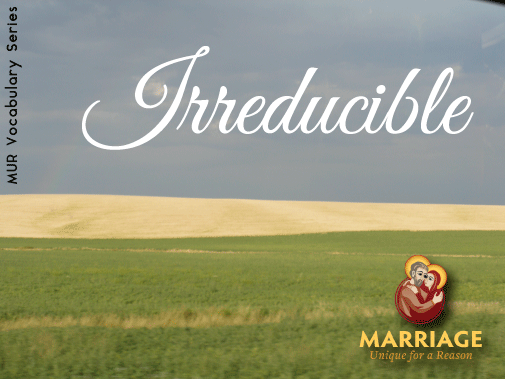 This is one of my favorite words in the realm of reflection on sexual difference because it reminds me that human being have limits that we must simply accept. Another term that is used to say the same thing is “insuperable.” One of the greatest lessons that we learn over and over again in relationships is: “other people are not me.” While this is certainly true in every case, between any two people, it is a particularly striking fact in the relationship between a man and a woman.
This is one of my favorite words in the realm of reflection on sexual difference because it reminds me that human being have limits that we must simply accept. Another term that is used to say the same thing is “insuperable.” One of the greatest lessons that we learn over and over again in relationships is: “other people are not me.” While this is certainly true in every case, between any two people, it is a particularly striking fact in the relationship between a man and a woman.
Taking the word in itself, irreducible denotes that a given thing is not-able-to-be-diminished. So not only can the thing not go away, it can’t even be lessened. We say sexual difference, then, is an irreducible difference. It cannot be any less than it is. A man cannot become somehow less a man in order to satisfy his wife, and a woman cannot be made somehow less a woman for her husband. In fact, in the union of marriage, each spouse will most likely find out for the first time just how different a man and woman are. Pope Francis preached in a homily for a celebration of Matrimony at the Vatican, “This is what marriage is all about: man and woman walking together, wherein the husband helps his wife to become ever more a woman, and wherein the woman has the task of helping her husband to become ever more a man.” Cardinal Scola of Milan writes, “You, woman, are as fully person as I, man. Yet you are this in a way that is radically different from my own, so decisive and so inaccessible. You are, precisely, other. Here we see all the force of the originality of man and woman.”[i] Thinking this way about sexual difference—as irreducible—can be a great help to the marital relationship, especially when it comes to expectations of understanding and agreement.
In Arabic, the word for “husband,” “wife” and “married couple” is one and the same: zawj.[ii] The language thus recognizes the mutual dependence and relationality of a man and woman in marriage, because it means “two persons, different from one another, bound together, who cannot manage without each other.”[iii] It highlights that the difference does not disappear in the unity.
In Chinese culture, the yin and the yang are symbols used to communicate a similar idea. “Though yin and yang look like opposites, they can’t exist independently. They embrace and coordinate each other, and also facilitate each other. One cannot exist or be defined without the other.”[iv] This Eastern concept can be helpful when thinking about the irreducible nature of the difference between the sexes: if the other is not, and never will be, you, only then can you be really tied to them in an inextricable way. Mirror images of ourselves cannot last.
[i] Angelo Cardinal Scola, The Nuptial Mystery (Grand Rapids, MI: William B. Eerdmans Publishing Co., 2005), p. 281.
[ii] Wael Farouq, “We Exist in Relationship,” Not Just Good, but Beautiful: The Complementary Relationship between Man and Woman, eds. Steven Lopes and Helen Alvare (Walden, NY: Plough Publishing House, 2015), p. 46.
[iii] Ibid, p. 46.
[iv] Tsui-Ying Sheng, “The Union of Yin and Yang,” Not Just Good, but Beautiful, p. 141.
Archive
Vocabulary Term: Theological Anthropology
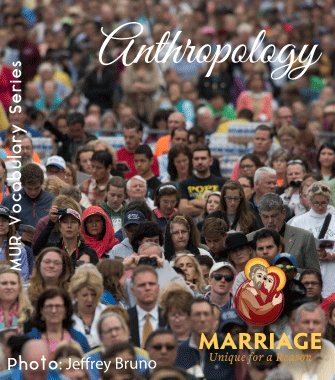 “Anthropology” is the study of human beings. Like many topics of study, it lends itself to further specification, such as our topic today: theological anthropology.
“Anthropology” is the study of human beings. Like many topics of study, it lends itself to further specification, such as our topic today: theological anthropology.
Since theology is the study of God, the juxtaposition of these two terms would be hard to understand or justify in any belief system besides Christianity. Only in Christ does God become man and thus open the door to the study of the human being in light of who God is. Since Jesus is true God and true man, not only can we consider ourselves in light of him, but we must, if we truly want to know ourselves.
Many—if not all—of the questions confronting the Church today about marriage (among other issues) have their roots in questions about anthropology—who man and woman are. This may be why Pope St. John Paul II spent so much of his pontificate exploring this question of who man is. In his very first encyclical, Redemptor Hominis, John Paul II quoted a phrase from the Second Vatican Council that would come to be one of his most-used lines: “Christ the new Adam, in the very revelation of the mystery of the Father and of his love, fully reveals man to himself and brings to light his most high calling” (Gaudium et Spes, no. 22). Only in light of this truth, he said, does man discover “the greatness, dignity and value that belong to his humanity” (RH, no. 10). John Paul II echoes this again in Veritatis Splendor, where he wrote, “only in the mystery of Christ’s Redemption do we discover the ‘concrete’ possibilities of man” (no. 103). And in Fides et Ratio, we read, “the more human beings know reality and the world, the more they know themselves in their uniqueness, with the question of the meaning of things and of their very existence becoming ever more pressing” (no. 1). Put another way, human beings are the creatures that ask, “Why?”
The whole of Pope St. John Paul II’s theology of the body could be understood as a reflection on theological anthropology. Beginning with Adam and Eve, in response to Christ’s direction in Matthew 19 to consider “the beginning,” John Paul II reveals the profound meaning of man’s being made male and female in the image of God. We are “Made for Each Other” and made to bring God’s loving presence into the world. The sexes can be understood as truly one and equal in dignity, but at the same time, totally different. This seeming paradox is possible only in light of a Trinitarian God, in whom difference is not subordination or conflict but the basis for fruitful communion.
John Paul II’s work is called an “adequate anthropology.” This doesn’t mean that it is “barely passable” as a way of understanding the human being. Instead, since we cannot know everything about ourselves, the Holy Father offers us an adequate place to start. (St. Augustine famously noted that God is “more intimate to me than I am to myself.”) In order to grasp something of our own mystery, we need to know, at the very least, that we are created man or woman, a son or daughter, and called to be a father or mother (in some way). Only this is an “adequate” beginning, a portrayal fitting to our identity as humans.
These considerations are ever more important as we approach the current cultural landscape, where every one of these assertions is questioned. We live in a world where people think that, instead of receiving their sexual identity as part of who they are, they should be able to choose their own sex, and that, instead of receiving new life as a gift, they seek control over the coming-to-be of new life, or its destruction. All of these choices have drastic consequences, not only for the individual soul, but for all of us.
Now even the government seems bent on forcing everyone to agree with this false anthropology—one that is not an adequate consideration of what and who a human being is. For example, take a recent veto of a bill in South Dakota regarding facility use. The measure, which passed both houses in the state legislature, would maintain the biological separation of bathrooms, but included provision of “reasonable accommodation” to those who consider themselves to be “transgender” (by providing single-occupancy restrooms, for example). This was not good enough, apparently—everyone must be forced to accept a person’s chosen “gender identity.” And of course the HHS Mandate is all about forcing everyone to provide contraception regardless of their convictions. The anthropology peddled today is a radical disassociation from reality, from the truth of ourselves as sons and daughters, fathers and mothers. We cannot allow this false anthropology to let us forget who we are.
Archive
Vocabulary Term: Reciprocity
The word “reciprocity” originated in the middle of the 18th century, from the Latin word meaning “moving backward and forward.”[i] It is defined in the Oxford English Dictionary as “The practice of exchanging things with others for mutual benefit.”[ii]
Reciprocity is a frequently-used term when referring to the relationship between the sexes. Many theologians, in particular, pair it with the word “asymmetrical,” so today we will look at these two words together.
Human beings like to have reciprocal relationships. With our relatives, friends, and particularly spouses, we do not like to feel as if one person does all the “giving” and the other all the “receiving,” (or, more cynically, the “taking”). We want to experience our relationships as balanced—even if our idea of balance does not match up with that of other people or society at large. Reciprocity means, in relationships, that there is a giving and a giving-back in love. As the actor in Made for Each Other says, marriage is not 50-50, it’s 100-100. But imagine if one spouse, Jack, feels they are giving 100% in the relationship, and the other, Jill, suspects that Jack is really only giving 75% of his effort into it, holding back on X, Y or Z. Trouble is bound to follow.
When I was in high school, I remember getting frustrated with my parents’ relationship, in which, from my perspective, my mom “did everything.” According to my enlightened (i.e., teenaged) mind, their relationship lacked reciprocity. Years later, I found out that my parents did not see it that way. My mom’s doing the chores was her way of showing love (acts of service), which is not the same as my dad’s.[iii] This is a reminder that reciprocity in a relationship cannot be measured from the outside.
Add “asymmetrical” to “reciprocity” and you have a closer approximation of the love of God. He always gives first. Our relationship with Him is always asymmetrical in that way. When we give to God, it is in response to Him who loved us first—“In this is love: not that we have loved God, but that he loved us and sent his Son as expiation for our sins” (1 John 4:10).
Marriage is also asymmetrical in a number of ways, many of which are based on sexual difference. The most obvious example is that of childbearing. It is indisputable that the woman gives more of herself to the infant for the nine months of gestation and a certain length of time after birth than the man does. This is not “fair” or “equal”; it may not even seem “complementary” since there is not really a parallel for the man. But it can (and must) be integrated into a relationship of reciprocity, albeit “asymmetrical”. A husband can certainly respond to the needs of his wife, especially after having a child, by supporting and encouraging her in any number of ways. Meanwhile, a man may be able give more of himself in some other way. For example, traditionally it is the man who kneels down to ask a woman to marry him; in this way he is imaging an “asymmetrical” type of love, a love that takes the first step and places itself at the service of the other. Marriage is full of little imbalances which, paradoxically, result in true balance.
[i] “Reciprocity.” Oxford Dictionaries. http://www.oxforddictionaries.com/us/definition/american_english/reciprocity (accessed February 23, 2016).
[ii] Ibid.
[iii] If you’ve never heard of the 5 love languages, check out Gary Chapman’s book, The Five Love Languages.
Archive
Prudence Allen, RSM on Complementarity
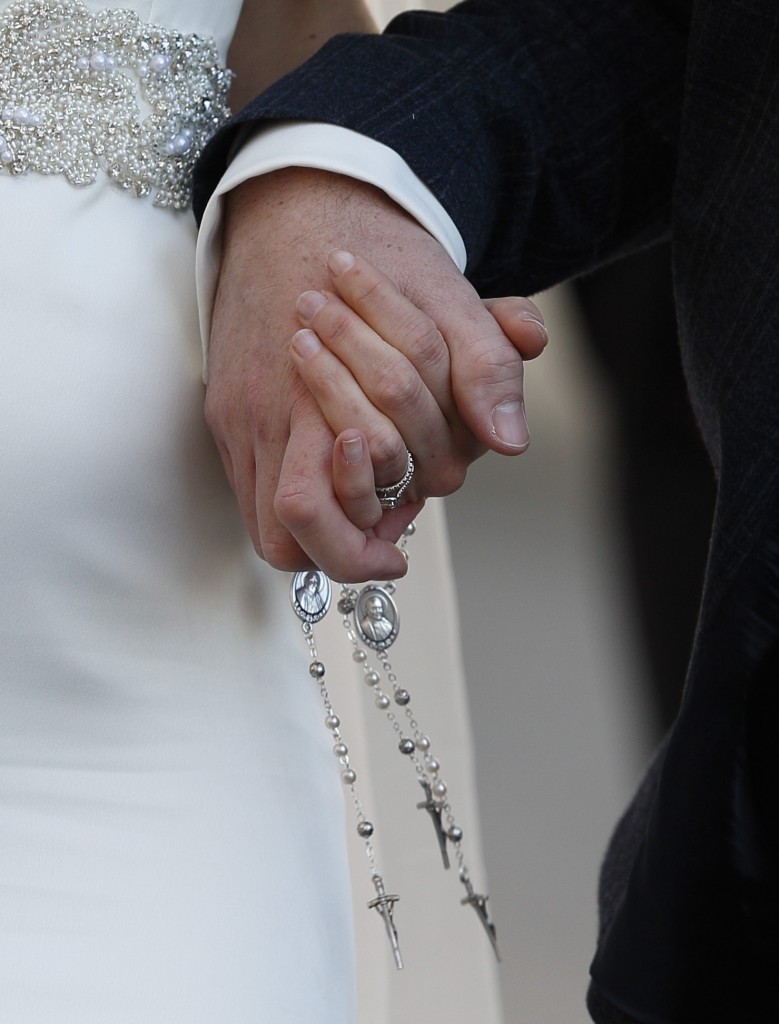
A newly married couple hold rosaries in their hands as they leave Pope Francis’ general audience in St. Peter’s Square at the Vatican Feb. 24. (CNS photo/Paul Haring) See POPE-AUDIENCE-POWER Feb. 24, 2016.
For the final February reflection on complementarity, MUR looks to Sr. Prudence Allen’s article, “Man-Woman Complementarity: The Catholic Inspiration” for insight. Allen is one of the most influential Catholic theologians in this particular area, and this article focuses on the historical development of the concept of integral complementarity which was mentioned last week.
Integral complementarity holds together the two elements of identity (equal dignity) and difference when it comes to the sexes. Allen writes, “When one of the two fundamental principles of gender relation—equal dignity and significant difference—is missing from the respective identities of man and woman, the balance of a complementarity disappears into either a polarity or unisex theory.”[i] Balance is a key word to keep in mind whenever the issue of complementarity arises.
Allen reviews briefly the historical development of theories on gender and sexual difference, pointing out that “fractional complementarity” (such as Plato’s idea of two “halves”) easily leads to stereotypes of what a man or a woman should do or is capable of, usually placing men in a superior position. On the other hand, ideologies like Marxism reject any acknowledgment of difference in preference of a unisex approach. Radical feminism seems to go in both directions at various times, taking a more fractional view in order to place women above men, or looking to abolish (forcibly, if necessary) any difference between the sexes.
To look at a Catholic understanding, Allen turns to Edith Stein (St. Teresa Benedicta of the Cross) and Dietrich von Hildebrand. Stein sees that the bodily difference between male and female is but a fraction of the whole picture, and that the true difference is metaphysical, since “Matter serves form, not the reverse.”[ii] Pointing out that a woman is created in such a way as to support life from within while a man does so in a detached form leads, Stein believes, to a fundamentally different experience of the world. She sees this as a woman being inwardly receptive and more personal and holistic in her thinking while a man is more outwardly focused and compartmentalized in his thinking. Allen notes that Stein’s thought has some weaknesses as to particular characteristics of masculinity and femininity, but she made a large contribution. Von Hildebrand emphasizes, like Stein, the metaphysical dimension of complementarity. Both man and woman are complete persons, in no way incomplete if they are not married, for example. When a man and a woman come together, though, “the effect is synergetic” and something new happens. Allen describes this with the formula 1+1à3.[iii] It is worth noting that this is not limited to the gift of a child (as wonderful as that is!) but applies in all areas where collaboration results in something that is greater than the sum of its parts.
The rest of Allen’s article (which I encourage you to read in full) is a survey of the excellent and unparalleled contributions of Pope St. John Paul II to this field of knowledge. His work deepened complementarity to the ontological level—in other words, he saw the difference between man and woman at the level of being, at the very center of their existence.
In conclusion, Allen writes that while the world and secular society vacillate between the two poles of polarity and sameness, the Catholic faith steps in to offer an integrated view in which man and woman are called together to “transform the world through a new evangelization of cooperation and interpenetrating work.”[iv]
[i] Prudence Allen, RSM, “Man-Woman Complementarity: The Catholic Inspiration” in Logos 9:3 (Summer 2006), p. 87.
[ii] Ibid, p. 93.
[iii] Ibid, p. 95.
[iv] Ibid, p. 105.
